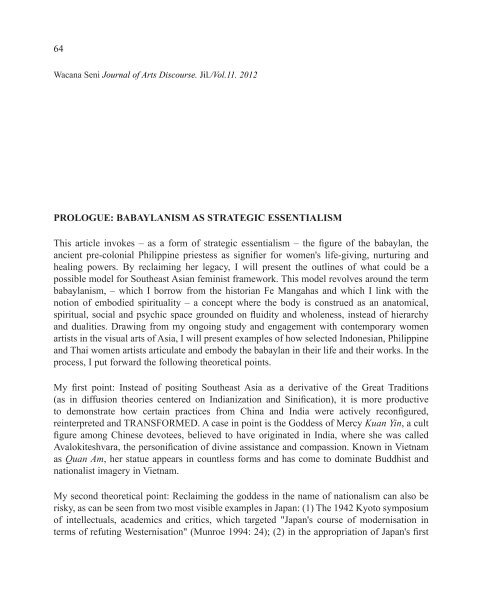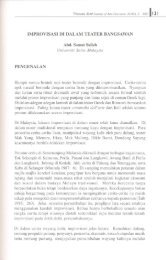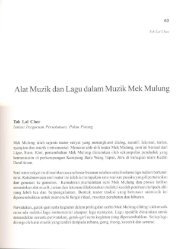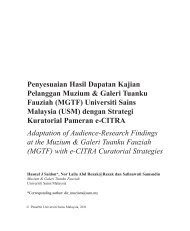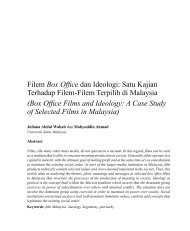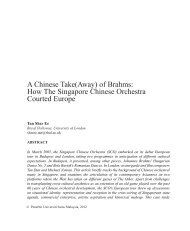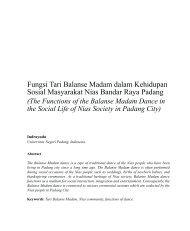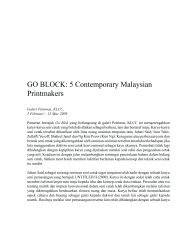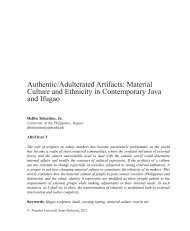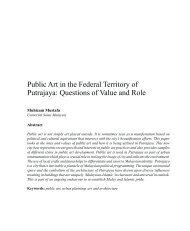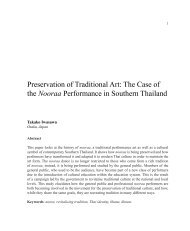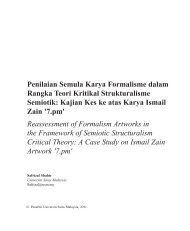Reclaiming The Healing Arts of The Ancient ... - Wacana Seni
Reclaiming The Healing Arts of The Ancient ... - Wacana Seni
Reclaiming The Healing Arts of The Ancient ... - Wacana Seni
You also want an ePaper? Increase the reach of your titles
YUMPU automatically turns print PDFs into web optimized ePapers that Google loves.
64<strong>Wacana</strong> <strong>Seni</strong> Journal <strong>of</strong> <strong>Arts</strong> Discourse. Jil./Vol.11. 2012PROLOGUE: BABAYLANISM AS STRATEGIC ESSENTIALISMThis article invokes – as a form <strong>of</strong> strategic essentialism – the figure <strong>of</strong> the babaylan, theancient pre-colonial Philippine priestess as signifier for women's life-giving, nurturing andhealing powers. By reclaiming her legacy, I will present the outlines <strong>of</strong> what could be apossible model for Southeast Asian feminist framework. This model revolves around the termbabaylanism, – which I borrow from the historian Fe Mangahas and which I link with thenotion <strong>of</strong> embodied spirituality – a concept where the body is construed as an anatomical,spiritual, social and psychic space grounded on fluidity and wholeness, instead <strong>of</strong> hierarchyand dualities. Drawing from my ongoing study and engagement with contemporary womenartists in the visual arts <strong>of</strong> Asia, I will present examples <strong>of</strong> how selected Indonesian, Philippineand Thai women artists articulate and embody the babaylan in their life and their works. In theprocess, I put forward the following theoretical points.My first point: Instead <strong>of</strong> positing Southeast Asia as a derivative <strong>of</strong> the Great Traditions(as in diffusion theories centered on Indianization and Sinification), it is more productiveto demonstrate how certain practices from China and India were actively reconfigured,reinterpreted and TRANSFORMED. A case in point is the Goddess <strong>of</strong> Mercy Kuan Yin, a cultfigure among Chinese devotees, believed to have originated in India, where she was calledAvalokiteshvara, the personification <strong>of</strong> divine assistance and compassion. Known in Vietnamas Quan Am, her statue appears in countless forms and has come to dominate Buddhist andnationalist imagery in Vietnam.My second theoretical point: <strong>Reclaiming</strong> the goddess in the name <strong>of</strong> nationalism can also berisky, as can be seen from two most visible examples in Japan: (1) <strong>The</strong> 1942 Kyoto symposium<strong>of</strong> intellectuals, academics and critics, which targeted "Japan's course <strong>of</strong> modernisation interms <strong>of</strong> refuting Westernisation" (Munroe 1994: 24); (2) in the appropriation <strong>of</strong> Japan's first


